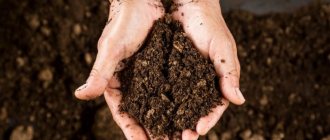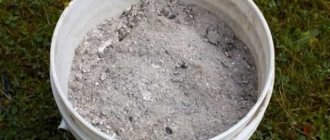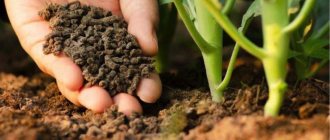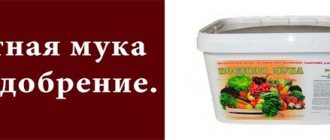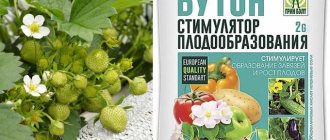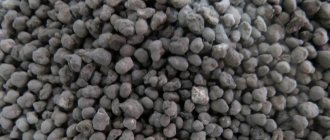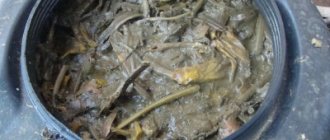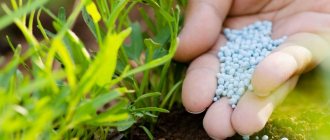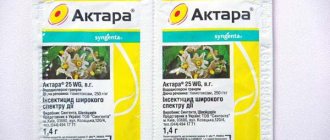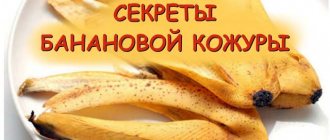Composition and purpose of Kalimagnesia
Potassium magnesia or potassium sulfate is a potassium mineral fertilizer. It consists of potassium - 28-30%, magnesium - 8-10%, sulfur - 17% and contains little chlorine - 1-3%. The name often used is Double Salt.
Available in the form of a mixture of granules or brick-gray powder. The fertilizer is highly soluble in water, although there may be sediment, and is easily absorbed by plants.
Not all plants tolerate chlorine. Kalimagnesia will be their salvation. It will deliver important nutrients without harming them. Potassium sulfate increases the yield and quality of fruit crops. The product is used for root and foliar feeding of plants.
Will be useful:
Using Urea in the country
We fertilize the garden with Nitroammophoska
Ammonium sulfate and the use of fertilizer in the garden
Benefits of using this fertilizer
Features that allow “Kalimagnesia” to be a very popular fertilizer:
- Water-soluble, leaves only a small sediment, due to which it is perfectly absorbed by the soil or plant.
- Positively affects soil and plant culture.
- Doesn't stick.
- Universal for use on different types of soil;
- Long shelf life.
- Contains a minimum percentage of chlorine and a maximum percentage of potassium.
- High efficiency on poor (sandy) and depleted, peaty, red soils.
- A harmonious combination of potassium, magnesium, and sulfur in its composition, which increases the effectiveness of application, promotes smooth and easy absorption of the contents of the fertilizer, prevents the rapid leaching of these elements, and moves weakly in the soil itself, providing maximum and systematic impact on the desired areas.
- Increases productivity and immunity, improves the taste and appearance of fruits.
Impact on plants
The fertilizer contains an optimal combination of microelements necessary to improve the taste of plant fruits.
Potassium
Potassium increases plant immunity to diseases and pests. Increases the content of sugars and vitamins in grown products. Feeding at the end of August and in September allows shrubs, fruits and berries and ornamental crops to survive the winter well.
Magnesium
Accelerates the growth of gardening and ornamental crops, stimulates the formation of starch and sugars. The drug increases plant productivity and improves the taste of fruits.
Without magnesium, the plant cannot develop properly. It is involved in photosynthesis, metabolism and the construction of plant tissue. Magnesium helps accumulate essential oils and substances necessary for fruit ripening.
Sulfur
Sulfur is part of protein, vitamins and is involved in the formation of enzymes. It contributes to the creation of environmentally friendly products because it prevents the development of non-protein forms of nitrogenous compounds.
Sulfur increases plant resistance to drought, temperature changes, and radiation. Its deficiency leads to a decrease in yield and product quality.
The use of the drug increases the starch content in potatoes and the amount of vitamins in green vegetables. Its use increases the % of sugar in beets and fruits.
Effect on soil
Typically, light, depleted, acidic, soddy-podzolic, red soils, as well as swampy and peat soils suffer from a lack of nutrients. The use of fertilizer on these soils will significantly increase the yield of almost all agricultural crops . The lower the percentage of chemical compounds in the soil, the more effective the drug will be.
Soddy-podzolic, gray forest and loamy soils should be fertilized carefully. This can only be done in regions with sufficient humidity.
The constituent elements of “Kalimagnesia” are well absorbed by the soil and act throughout the whole year. The drug harmonizes the composition of the soil, positively influencing the crops growing on it . It also prevents the leaching of magnesium from the soil, which accompanies the cultivation of some crops (tea).
How does the Calimagnesia fertilizer affect the soil?
Although “Kalimagnesia” is a universal fertilizer, agronomists do not recommend using it on chernozems, southern gray soils, and chestnut substrates: the fertilizer will only increase their salinity, so it is better to find other substances for fertilizing.
When to apply Calimagnesia
Potassium magnesium as a fertilizer is applied to the soil in the fall on heavy soils, and in the spring on sandy and sandy loams. In summer, the drug is used while loosening the soil and, as necessary, throughout the growing season.
There are 16 grams of Calimagnesia in a tablespoon, 5 in a teaspoon, and 20 grams in a matchbox.
Application in spring
In spring, apply 10 g of fertilizer per 1 square meter. meter, at the time of digging the site. Apply 5 g of product per 1 square meter into the furrow. meter. In early spring, it is advisable to combine the use of the drug with ash, calculating 1.5 kg of ash, which is slightly less than 1/3 of a bucket per 1 square meter. meter.
Root feeding of crops is carried out at the time of planting. Use 20-30 g of the drug per 1 sq. meter for shrubs and trees. For vegetables – 15-20 g of product per 1 sq. meter, root vegetables require 20-25 g of substance per 1 sq. meter.
In the early phases of plant development, feed the crops, use 9 g of the drug per 1 square meter. meter. Repeated feeding is carried out in late spring in the amount of 20 g of the drug per 1 square meter. meter.
Autumn fertilizing with Kalimagnesia
In autumn, the drug is used in an amount of 20 g per 1 square meter. meter when digging the ground. When digging a greenhouse or hotbed, use 40 g of the substance per 1 square meter. meter.
Indications and contraindications
The conditions that determine the possibility and effectiveness of fertilizing with potassium magnesia are determined primarily by the composition of the soil on the site; then plants on it. Among and in addition to them are chlorophobe plants (nightshades, legumes, buckwheat, all trees and woody ones) there are “magnophiles” that respond well to magnesium (potatoes and other root vegetables) and sulfophiles that consume a lot of sulfur (cruciferous vegetables and legumes). All of them will benefit from potassium magnesia on suitable soil.
The soil
Potassium and magnesium are necessary, but rather insidious elements of plant nutrition. Overfeeding them does not immediately and strongly manifest itself, but weakens the root system. Therefore, fertilizing with potassium magnesia is definitely needed on soils poor in these elements:
- Podzolic and sod-pozolic; especially on fallow podzols left over from cleared forests.
- Sandy and sandy loam.
- Peaty.
- Dark alluvial (floodplain river).
The last 2 types of soils are acidic, so the use of kalimag on them must be combined with liming, because The chemical reaction of potassium magnesium itself is close to neutral. It is also preferable to apply potassium magnesia to acidic soils only in the fall.
Potassium magnesium is definitely contraindicated for chernozems, chestnut, loess and any carbonate soils - there is always an excess of magnesium in them, and a lack of sulfur, if observed (see below), is replenished with potassium sulfate. The deficiency of magnesium and sulfur (which is extremely rare) is compensated for by magnesium sulfate, but potassium and magnesium cannot be given on such soils. As for clayey, gray forest and red earth soils, they need to switch from potassium sulfate to potassium magnesia when signs of potassium and sulfur starvation appear; the effect, however, will only appear next year. In the current year, you need to make up for the deficiency again with potassium sulfate, and the next year after adding potassium magnesia (“the next year” from the current one), you no longer need to use it, but carefully monitor the plants - there will almost certainly be no signs of potassium-sulfur starvation. If they suddenly appear, you’ll have to reapply Kalimag again in a year.
Potassium deficiency in plant nutrition is manifested quite clearly by the marginal chlorosis of leaves, and especially by the pale ends and “waist” of cucumbers, see on the left in the figure:
Signs of potassium and sulfur deficiency in plant nutrition
But recognizing sulfur deficiency without experience is not easy: its symptoms are similar to nitrogen chlorosis, on the right in Fig. To check, you need to pull the affected middle-aged leaf down by the tip: if it breaks off easily, the problem is nitrogen. If it resists and/or comes off not at the junction of the vagina with the stem, but at the petiole, but there is not enough sulfur. Well, a sign of magnesium deficiency is also clear - chlorosis of the lower old leaves.
Plants
Calimagnesia is useful not only for plants that are responsive to it. On lands poor in magnesium, sulfur and microelements in general, Kalimag allows, without resorting to expensive means of soil reclamation and increasing productivity, to achieve greater marketability of the fruits of any crops and thereby increase the profitability of the site. Of course, the reclamation of depleted lands is necessary, but it can only be truly effective when there is income from the site - otherwise the costs will never be recouped. The dosage of potassium magnesia for different types of plants is calculated based on the trace. considerations:
- The mass fractions of potassium, magnesium and sulfur in potassium magnesium are of the same order.
- Potassium is the main element of plant nutrition; magnesium is a mesoelement, and sulfur is a microelement.
- The proportion of pure sulfur in potassium magnesium is much less than that by weight, because sulfur in kalimag is present in the form of sulfate ions.
- Even the most notorious sulfophilic plants do not “eat up” sulfur, i.e. do not accumulate it in themselves.
- An overdose of potassium, like other basic nutrients, has a much stronger effect on the condition of plants, the size and quality of the crop.
- An excess of mesoelements, in turn, is more sensitive than microelements.
Based on this, potassium magnesium doses are calculated based on magnesium. If the potassium deficiency remains, it is replenished with other potassium or complex fertilizers. But the application procedure and general feeding techniques are taken for potash fertilizers, see video:
Video: general procedure for applying potash fertilizers
How potassium magnesium is used for various crops is shown in the table below:
Norms for applying potassium magnesia for various crops
The following must be taken into account:
- In the fall, Kalimag is applied before plowing or digging the site: autumn Kalimanesia should be buried in the ground by 10-12 cm on heavy soils, by 10-15 cm on medium soils and by 15-20 cm on light soils. Fraction – chopped.
- In spring, potassium magnesia is applied by scattering over the surface before harrowing or manual raking. Fraction – granules according to soil properties, see above.
- Spring potassium magnesium is applied a week before planting.
- Seasonal feeding is carried out with powder or the smallest granules in the evening, scattered over the surface of well-watered soil.
The following is also taken into account. Firstly, potatoes are the most responsive crop to potassium and potassium in general. But without strong active roots and green mass, there will be no good potatoes. Therefore, you need to know the general rules for fertilizing potatoes with potassium, see next. video clip:
Video: how to fertilize potatoes with potassium
Secondly, you need to be especially careful with cucumbers, and among them, greenhouse ones. Cucumbers have weak surface roots and long vine-stems with a not very perfect conducting system. The roots of cucumbers suffer more from excess potassium than other crops, so you need to know the general rules for feeding cucumbers, see story:
Video: about feeding cucumbers
And finally, bulbs, root vegetables and cabbage. Regardless of how sensitive a given crop is to chlorine, part of it will be deposited in storage plants: bulbs, root vegetables, cabbage leaves. Including the most dangerous and insidious 36Cl. Therefore, only safe and/or proven potassium magnesium should be applied to such plants.
Weight distribution with anything
Potassium magnesium is not a particularly demanding fertilizer when it comes to dosage. Therefore, measuring its portions for a small area is more convenient and much faster using improvised means:
- 1 tsp. with a top without a slide – 5 g;
- 1 dessert spoon, also with a top without a slide – 10 g;
- 1 tbsp. l. also filled – 15 g;
- matchbox – 20 g;
- faceted vodka glass (without rim) – 200 g;
- faceted tea glass (with rim) – 250 g.
- household beaker - as many grams as the division is poured (starting from the 5 ml mark.
Note: just in case, in the table. see the dosage of other fertilizers according to the container (glass - vodka). For all except superphosphate, chalk and ash, the data is valid when weighing dry, not stored chemical. In fact, weighing out fertilizers using improvised means is a subject for a separate discussion, but don’t write an article whose whole meaning is in one picture.
The advantages of fertilizer are:
- the ability of the drug not to cake and its non-hygroscopicity;
- increases crop immunity to diseases and pests;
- forms frost resistance of crops;
- accelerates fruit ripening;
- reduces nitrate content;
- increases crop yields;
- remains active in the soil throughout the year.
The disadvantages include:
- impossibility of use on chernozem, loess soils and solonetzes;
- the ability to make the soil unsuitable for cultivation if the drug is used excessively or incorrectly;
- the product may cause poisoning if it enters the respiratory tract.
Instructions for use of Calimagnesia
The drug is used in dry form and in solutions, when digging the ground, for root and foliar feeding.
Under the root
We have already said how to feed crops at the root during planting. It is better to do subsequent feedings with a liquid preparation.
For irrigation, the fertilizer is diluted in hot water, allowed to stand for 3 days, and stirred every day. Then the sediment is drained and used.
Calimagnesia is used for irrigation in a dosage of 10 g of the drug per 10 liters of water.
This dose is consumed per 1 sq. landing meter. For vegetable crops, the amount of fertilizer increases to 20-25 g.
Foliar feeding with Calimagnesia
Potassium magnesia as a fertilizer for foliar application is diluted in hot water.
The solution is prepared in the ratio of 20 grams of the drug per 10 liters of water.
The application rate for the spraying solution is as follows: 5 liters per hundred square meters.
Application with granules
The application of the drug in granules, as mentioned above, is carried out when digging the area and planting crops.
The rate of application of the substance depends on the fertility of the soil, the crop being grown and the planned yield. In physical weight, 10-40 g of the drug per 1 square meter is used. meter. For the main application, use 40 g of product per 1 square meter. meter.
Estimated prices for potassium magnesia
The drug is available and sold in most gardening stores. It is packaged in bags of 0.5-3 kg. Wholesale buyers can purchase 40 kg bags. When choosing, take into account the permeability of the soil: the heavier it is, the finer the granules should be.
The cost ranges from 70 to 130 rubles. for 1 kg. The price depends on the manufacturer. It is not recommended to buy drugs produced near the Chernobyl zone or nuclear power plant.
When used correctly, potassium magnesia brings tangible benefits to plants. The fertilizer covers the needs of crops for potassium, magnesium and sulfur, stimulates growth and fruiting. The dosage, method and frequency of treatment depend on the crop. It is important not to exceed these limits so as not to have the opposite effect.
How to use Calimagnesia
For roses
Roses do not tolerate chlorine in fertilizers more than other flowers . Therefore, Calimagnesia is well suited for them as a fertilizer.
The product is used both in spring and autumn, 20 g per 1 sq. m. meter. Embed it in the soil at a distance of 0.2 m from the bush. Foliar treatment of plants is carried out in the first ten days of June and early autumn. The drug is used in the same ratio.
Potassium magnesium for tomatoes
When cultivating the soil, you need to add 100-150 g of the drug per 1 square meter. meter. 4-6 treatments are carried out per season.
Feed with a solution in a ratio of 20 g of substance per bucket of water.
The productivity of tomatoes after using Calimagnesia increases by 1.5 times.
Feeding cucumbers
Fertilizer is often used before sowing.
Scatter the dry substance in an amount of 100 g per 1 square meter. meter before rain or immediately after applying the product, water it generously. After 2 weeks, repeat the procedure using 200 g of the substance per 1 square meter. meter. The culture is fed again with 400 g of the product after 14 days.
Potassium magnesia for potatoes
Using fertilizer to feed potatoes will increase their shelf life and the starch content in the tubers.
Apply the product 3 times per season:
- 1 teaspoon of the drug when planting in each hole;
- before hilling 20 g per 1 sq. meter;
- during the period of tuber formation, use 20 g of the substance per 10 liters of water.
For strawberries
Strawberries are fed in August.
Potassium magnesium as a fertilizer is used in the amount of 35 grams of the drug per 1 square meter. meter. After use, the substance is sprinkled with earth.
Grapes
Thanks to the addition of potassium sulfate, the grapes become sweeter and more resistant to frost. At the moment of fruit ripening, the crop is watered with a solution of the drug at the rate of 1 tablespoon per 10 liters of water. Use 1 bucket per bush and with an interval of 2 weeks the treatment is repeated 2 times.
Fertilizer for conifers
Both garden and wild plants are fed with potassium sulfate.
The drug is used in spring and autumn, retreating from the trunk by 40-50 cm. The drug is poured into the trunk circle in the amount of 35 g per 1 sq. m. meter and sprinkle with earth.
Feeding flowers
Flowers are fed with the product twice: before flowering and at the end of the season. The first time, foliar treatment is carried out, the second - root feeding of plants. Use 25 g of the drug per bucket of water.
Why feed raspberries in the fall?
The root system is the most important component for any plant. The deeper it is located in the soil, the more resistant the crop is to frost.
Raspberries have roots that are not too deep, so the bushes need help preparing for frost. Autumn feeding of raspberries is considered an important part of preparing the plant for winter.
In addition, thanks to the introduction of nutrients into the soil, the crop has the opportunity to fully recover by the next fruiting. The procedure should begin no earlier than all the berries have been collected from the bushes.
- Basically, for ordinary varieties, August - the first week of September is considered acceptable.
- and fertilizing of remontant varieties begins no earlier than the end of September.
Fertilizer feeding is carried out approximately a month and a half before the rainy season and 2-2.5 months before the first frost.
In the northern regions, cold weather occurs much earlier than in the southern regions, therefore, raspberries need to be processed earlier. Each year the dates may change depending on weather conditions.
Reviews on the use of Calimagnesia as a fertilizer
Natalia, Bogolyubovo
In my garden there are roses of a wide variety of varieties and shades. There were cases when they froze in winter. I started using the drug Calimagnesia and have not had this problem for several years now. And the flowers themselves became larger and brighter.
Varvara, Petushki
I use Kalimagnesia to feed various vegetables. For cucumbers, I use mullein or chicken droppings along with potassium sulfate. The foliage does not turn yellow and the vines do not dry out until autumn. Cucumbers are sweet, not bitter, strong and crispy.
Conclusions about Calimagnesia
- Potassium magnesia as a fertilizer has the ability to increase the sugar content in crops.
- Thanks to its use, the amount of starch in potatoes increases.
- When using the product, plants become immune to diseases and frost.
- But gardeners must remember the rules for using and storing the drug.
About the author: Artem
I grew up in the outback and know what a garden is. For the last 3 years I have been the editor-in-chief of a gardening website. Most of all, I prefer to implement new ideas in my garden plot, try different growing methods, and introduce modern methods for increasing the yield. But at the same time, he is a supporter of the “old-fashioned” methods of feeding and treating garden plants using folk methods.
Other articles by the author | Web site
How does the drug affect the soil?
The potassium-magnesium mixture will not be beneficial if used on soil types such as black soil or sulfur soil. Experiments on salt licks also showed a negative effect.
Although it is worth pointing out that plants such as sunflowers and sugar beets feel much better when using Calimagnesia on these soils. And development is accelerating.
The main components of potassium and magnesium fertilizer will have a beneficial effect on the land, which is classified as peat bog, red soil. In swampy areas, kalimag is doubly necessary. Productivity increases.
